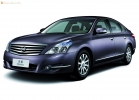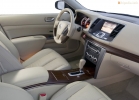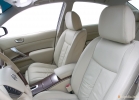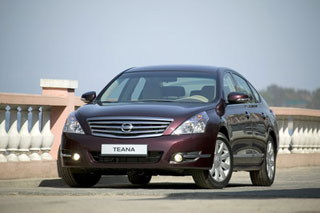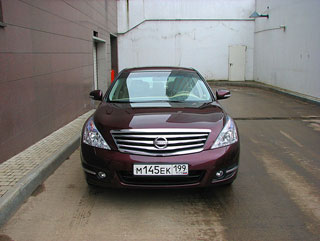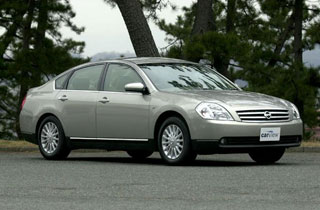Nissan Teana test drive since 2008 sedan
The color of "sofas"
 Skilling science is small in cars. Although no great automobile journalist, of course, is recognized in this. All these elusively subtle matters of the differences between, say, crossover and SUV were invented with one purpose to hang marketer noodles on the ears of ordinary mortals as much as possible.
Skilling science is small in cars. Although no great automobile journalist, of course, is recognized in this. All these elusively subtle matters of the differences between, say, crossover and SUV were invented with one purpose to hang marketer noodles on the ears of ordinary mortals as much as possible. In fact, there is a much more understandable approach to modern automobile consumer goods. It is much more understandable (and probably more interesting) to associate cars for their purpose. For example. Take the same UAZ or, say, Land Rover Defender. These are cars like swamp boots. The mud has a pleasure in them! But go a week in your office in swamps. Colleagues will soon surrender you in a madhouse. However, at the same time, amateurs every day pushing on these tanks on traffic jams for some reason, for some reason, no one even surprisingly cause a hint.
There are city small vehicles. They are taken with them, leaving the house in the morning, and elegantly park for the whole day in the gap between the garbage tanks in some courtyard in a pair of quarters from the office.
And there are vehicles. Their owners are divided into two subspecies. The first corporate fleets transporting branded bodies. This is a separate topic. The second type of the owner of the sofa mobile is more close to us spiritually and ideologically: ancient American folk fun to sit on the couch in front of the telly with a beer and chips launched the most powerful roots in the domestic loam. Therefore, we really need vehicles. Highly! Nissan Teana and Renault Latitude typical representatives of this class. According to the abstruse modern classifications, both belong to the D+segment. Very exciting size. And not only a car. For example, a woman with this size almost guaranteed to become an epicenter of any male company. What Teana, that Latitude ladies are very overall and casual.
The Frenchwoman appeared on the domestic market relatively recently, at the end of last year. We have known the current generation of Japanese much longer, about two years. However, an unequal battle in the process of comparing these four -wheeled sofas will not work. In fact, Nissan Teana and Renault Latitude Gemini: both are made on a common platform. This fact simultaneously simplifies and complicates the comparison.
Theoretically, cars with similar engines, gearboxes and a whole bunch of identical pieces of iron in the insides should make an identical impression. But no. It is this equality that brings the nuances to the forefront, small, seemingly details. However, it is they who most often form the basis of the subjective perception of the machine by man. The devil lies in the details, as you know, fun was added by the fact that the cars that fell on the test turned out to be painted in the same color of the brown metallic, awakening in the subconscious nostalgic memories of the once fashionable Russian color, known as eggplant. Find ten differences to start the game immediately from lighting equipment. Unlike the acute-angle style of the front-line container, the teana blocks are horizontally oriented forms of similar devices of the Frenchwoman look more calm and harmonious.
The false radiator grilles of cars, although decorated with different emblems, still have a general similarity. But in the design of the file parts, designers managed to achieve a greater variety. Japanese lanterns make a completely different impression than the French parallels of stop symbols and turn signals. Moreover, in the variant from Renault, the rear block-phara is also interconnected with the help of a chrome trunk strip. Here, in fact, is all the main external differences. But the interiors of cars are much more diverse. First of all, the dashboard. Teana has three large circles built horizontally, and red arrows dominate: a speedometer with an on -board computer monitor, a tachometer and the indicators of fuel and temperature covered by a common circle. Latitude has white arrows, speedometer, tachometer, side comprehension between them, and small coins of fuel level indicators and temperature below. In both cases, everything is perfectly read, but the French version is perceived as more stylish. However, we have already seen this on the same Renault Laguna. In the salons of both machines, navigation system monitors flaunt. However, if the Nissan Teana has a multimedia system with an active full -size display, then Latitude only navigator. But with the connected rear view camera. These gadgets are controlled using steep-jaostiki. Their management algorithm is simple and intuitive. However, in Latitude, this same joystick is installed almost between the front seats, and to use it, just drop the hand next to the machine gun’s handle, and in Teana he perched at the upper part of the central console, it has to be slightly stretched to it. According to the level of other ergonomics, the quality of finishing materials and the like interior indicators of the machine go to the nostril in the nostril.
The vast majority of the options, including the engine launch from the button under the wheel and locking the car with a button on the outer door, is duplicated. The differences in the design of the interiors are due only to the currently adopted corporate dress code. Well, the rear passengers feel equally freely on the pillows of the seats of both sofas mobiles. The dimensions of the luggage departments also fully confirm the belonging of cars to this class.
To compare the car's running qualities in the most correct way, we have chosen cars with 2.5-liter engines (V-shaped sixes). True, in Teana he gives 182 hp, and in Latitude 177 hp. No, the engine is the same, the minimum difference in power is most likely explained by the intricacies of branded settings. But with the gearboxes some conflict. Nissan Teana is equipped with CVT variator KP.
And in Renault Latitude, such an engine is aggregated exclusively with the hydrotransformer KP, although the 2-liter power unit, also installed on this machine, is perfectly associated with a similar Nissan CVT. Let us leave this riddle on the conscience of the designers and marketers of the Nissan-Renault alliance and consider the cars on the go. Well, what can I say: they are sofas in Africa sofas. What Teana, that Latitude in the sense of running qualities are completely adequate to their furniture role. The smooth and imposing gait of both cars both on the highway and in the city unobtrusively dictates a very definite style of driving under the motto: we will have time everywhere because we never hasten!. Turning these cars into racing cars is quite problematic. But this is not required. The dynamic characteristics of the machines are such that, sitting at the wheel of this Nissan and this Renault, you feel as comfortable in the stream as in some German of a similar class. This is a general assessment. But something curious is discovered in the privileges. Dry numbers (10.7 seconds up to hundreds of Renault Latitude against 9.6 for Nissan Teana) at first glance are not a great difference. But this is not so. And the point here is far from a meager difference in motors capacity. Against the background of a smooth and clearly working variator Teana, a traditional 6-speed Latitude machine seems frankly braking. To get used to his delay in transfers of the gears, of course, you can say so used to it before and were satisfied. It is possible, but only if you don’t know that at this time the driver, ono-on that Teana, just pressed the gas and went, feeling only even and powerful acceleration. And the machine is also guilty of an excess liter (at least) gasoline per 100 km of run in devoured. In general, Nissan Teana seemed more driver as Renault Latitude. And the point here is not only in different KP. The sofa suspension from Japan seemed a little more collected. For example, on long transverse asphalt waves, Latitude's behavior reminded a motor boat crossing gentle wake waves from a sand barge. The Teana suspension in similar conditions soothed the vibrations of the body, not more effective.
The most budgetary equipment Renault Latitude with a 2.5-liter SonFort engine, that is, almost maximum. Therefore, the price of such a machine will be 1,165,000 rubles. The basic Latitude, equipped with a 2-liter engine and variator, costs 835,000 rubles. Nissan Teana from 969 000 rubles (2.5-liter engine and CVT). However, in the configuration comparable to the Reno SonFort, the price of the Japanese machine will be 1,151,000 rubles.


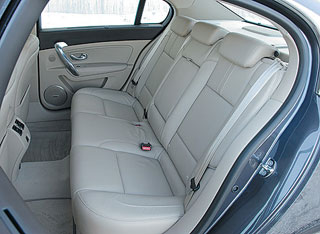
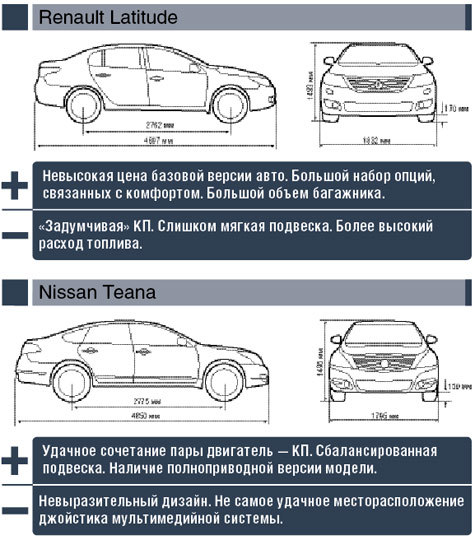
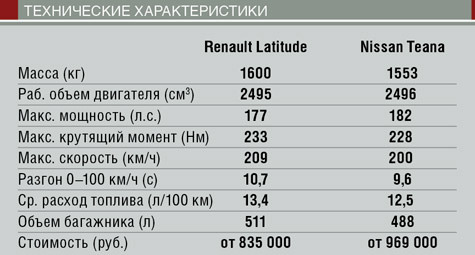
Certificate MK
Few of the proud Japanese Nissan Teana suspects that for the first time it was presented to the public under the name Samsung SM-5. True, only the Korean public. Later, Teana appeared on its base, and then a car under a typically French larva of Renault Latitude. And what do you want, globalization and all kinds of cost reduction
Source: MKOMBILA magazine [May/2011]
Nissan Teana Test Drive Video since 2008
Nissan Teana Crash Test Video since 2008
Nissan Teana test drive since 2008
Nissan Teana malfunctions since 2008
Nissan Teana malfunctions: Detailed information| Teana since 2008 | |
|---|---|
| Engine |  |
| Transmission |  |
| Control system and suspension |  |
| Brake system |  |
| Air heating and air conditioning |  |
| Launch and charging system |  |
| Electric components and so on |  |
| Corrosion body stability |  |

